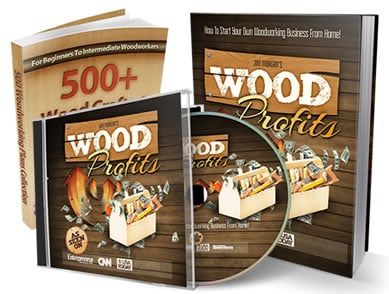Subscribe to DIY with Dave on YouTube
Since the late 1960s, lumber futures have served as a reliable way to estimate the price of lumber that consumers pay at the end of the supply chain. By examining lumber futures prices over the past five years, we can observe significant fluctuations due to various issues, including transportation problems, factory shutdowns, worker shortages, and more.
However, in recent months, lumber prices have stabilized considerably. Despite this current stability, there are notable changes on the horizon.
Lumber futures act as leading indicators for wholesale prices at retailers such as Lowe’s, Home Depot, and other lumber yards, ultimately impacting the prices paid by consumers. While the intricacies of lumber futures have been explained in previous videos, there are a few key points to understand in order to grasp the current situation.
Want To Improve Your Woodworking?
Discover 1,000 Hours Of Step-By-Step Woodworking Videos

It’s called Woodwork101. A database of detailed videos and blueprints in crystal clear, mouth-watering HD that will take you by the hand and show you that DIY home projects done the right way are easy, fun, and always of top quality… turning dream into reality in a heart-beat. Getting you that perfect build each and every time.
Firstly, lumber is classified as a commodity, a good used in the production of other goods. Commodities are typically traded on the Chicago Mercantile Exchange (CME), serving as the stock market for various commodities such as crude oil, precious metals like silver and gold, base metals like copper and iron, and even agricultural products like beef, pork, wheat, and rice.
Lumber is also traded on the CME, either as futures contracts or options contracts. A futures contract binds the buyer to purchase and the seller to sell a predetermined amount of a commodity at a specific price and future date. On the other hand, an options contract grants the buyer the right, but not the obligation, to buy or sell a commodity at a specific price and future date.
Trading commodities is not limited to Wall Street traders; many legitimate reasons exist for individuals and companies to participate in commodity trading. For example, airlines, which consume significant amounts of fuel, may use oil options or futures to forecast their costs and hedge against drastic price increases.
Similarly, car manufacturers may employ the same strategy with steel, while companies like McDonald’s may do so with beef and grain. In the case of lumber, sawmills, wholesalers, retailers, and home builders all engage in the lumber futures market.
[Video] 3 Most Common Mistakes
When Setting Up Shop

A woodworking friend of mine shared this video by Ralph Chapman with me that helped him set up his workshop.
The video explains the benefits of Ralph Chapman’s guide about setting up an affordable workshop and avoiding the most common mistakes offers to anyone interested in woodworking.
To illustrate the concept of a futures contract, let’s consider a home builder as an example. Suppose a home builder plans to construct several houses, and there will be a few months delay between the approval of plans and the pouring of the foundation before they require lumber. If lumber prices rise during that period, the builder will face financial losses.
Therefore, to hedge against potential price increases, they may opt to purchase lumber futures to be delivered when they need the lumber.
Now, let’s discuss the significant changes that are taking place and their potential implications for future lumber prices. The CME, which regulates these contracts, is revising its rules. Here are the key changes:
#1 Contract Size: Previously, one lumber futures contract represented a volume of lumber equivalent to a rail car, approximately 110,000 board feet. However, the contract size has been reduced to one-fourth of its previous size, now representing 27,500 board feet, which is roughly the amount of lumber required to build an average home in the United States.
#2 Delivery Point: Previously, the delivery point for lumber futures was in British Columbia, and the price was determined as it left that location. This approach did not consider the additional transportation costs incurred to transport the lumber from British Columbia to its destination. The new delivery point is in Chicago, a central location that accounts for both eastern and western lumber. This change ensures that transportation costs are factored into the overall cost of the lumber futures contract.
#3 Expanded Lumber Types: The CME is also broadening the range of lumber species available for trading. Previously, the focus was primarily on species from the Pacific Northwest. However, with these changes, lumber futures will include species from the East and South as well. This reflects a shift in the source of lumber supply, as mills in the Pacific Northwest are closing, and production is shifting to more central regions.
[Guide] How To Launch Your Woodworking Business For Under $1000
Click Here To View
If you’re considering turning your woodworking hobby into a part-time business check out this helpful guide on how to get started.
What do these changes mean for the lumber market? Firstly, they make lumber futures more accessible and liquid, allowing smaller lumber yards and home builders to participate more easily. The reduced contract size and central delivery point facilitate smoother trading and provide opportunities for a broader range of participants.
Considering the impact on prices, there are a few noteworthy observations. The old lumber futures contracts ceased trading in May, and the new contracts have been traded since August. Comparing the prices of the old and new contracts, we see a consistent trend where the new futures prices are consistently around $100 higher than the old futures prices.
This increase is attributed to transportation costs to Chicago, which were likely being paid previously but not factored into the futures contract. Additionally, as the expiration date of the old options contract approached, trading activity decreased, which may have influenced a slight decrease in prices.
In summary, these changes in the lumber futures market are generally positive. They increase market liquidity, ease entry and exit for participants, and reduce extreme price volatility. Notably, democratizing the market allows smaller companies to engage in futures trading, which was previously financially challenging.
174 Woodworking Tips & Tricks

However, in terms of end-consumer prices, these changes are unlikely to have a significant impact. The retail prices of lumber closely track the lumber futures prices, albeit with a slight lag. Looking at retail prices over time, we can observe a decrease in volatility and a recent period of stability.
Moving forward, the factors that will continue to impact lumber prices are those related to supply and demand. Exploring these factors will be the focus of future videos, including the impact of supply and demand dynamics on lumber prices.



